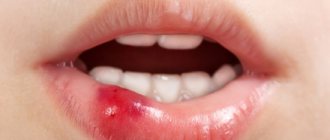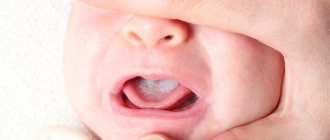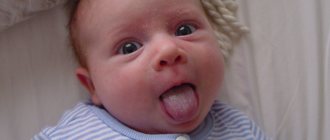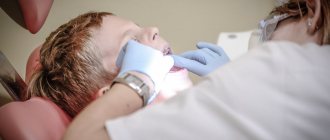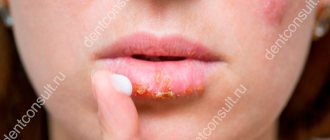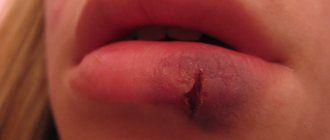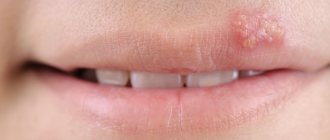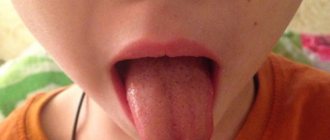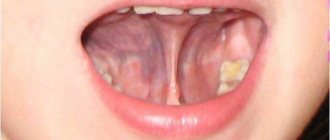Labial frenulum tears are injuries in the mouth. They may cause bleeding but rarely require medical attention.
The labial frenulum is a thin layer of tissue that connects the lips to the gums and bones of the face. There are two different types of labial frenulum:
- the maxillary labial frenulum, which connects the upper lip to the mouth;
- the mandibular labial frenulum, which connects the lower lip to the mouth.
The frenulum of the lips helps keep them in place while the jaw and facial bones grow.
These injuries are usually treated at home, but in some cases medical attention may be required.
First aid for a ruptured upper frenulum
Upper frenulum ruptures are common in children. The main symptom is bleeding from the upper gums and lips.
These injuries rarely require treatment and heal without stitches.
First aid tips for a torn frenulum include:
- Press your outer lip against your teeth for 10 minutes to stop bleeding;
- do not pull out the lip to check the injury, as this may renew the bleeding.
Be sure to check for other signs of swelling or infection after 3 days. After this time there should be no bleeding.
Possible consequences
Often minor damage does not cause any unpleasant consequences. The same thing applies if the mucous membrane has been restored to its normal state. If medical correction has not been carried out, the tissues have grown together incorrectly, this can cause problems as a person grows and in his later adult life:
- problems with pronouncing certain sounds, especially if the injury occurred before the baby first spoke;
- susceptibility to infections of the oral cavity, if the tissues have grown together crookedly, there is no normal oral hygiene;
- Gastrointestinal problems can occur due to the fact that children do not chew food well after gum injuries.
Kids are active and curious, they require the attention and responsible attitude of adults. Childhood injuries happen everywhere; the frenulum can tear even from excessive efforts when brushing teeth or a minor bruise; only the doctor decides whether to stitch it up or not. Many speech therapists do not see a connection between such damage and poor diction. Parents should not be afraid of a protruding lip after surgery. A child can even tear the mucous membrane several times; the main thing is not to panic and maintain a reasonable approach to the treatment and prevention of injury.
The article has been verified by the editors
Can it heal on its own?
Most frenulum tears heal on their own in 3-4 days. Infections or other complications are rare.
While the injury is healing, you can apply a cold compress to it for 20 minutes to relieve pain.
Over-the-counter pain relievers such as Tylenol or ibuprofen are also helpful.
After a frenulum rupture, it is important to stay hydrated. A person should stick to soft foods to avoid chewing and avoid salty, sour or spicy foods. This may irritate the wound.
What is it and why do we need it?
Such anatomical formations are the thinnest folds of the mucous membrane that connect the mobile lips and tongue with the fixed parts of the oral cavity: the gums and the sublingual space.
In total, there are three frenulums in the baby’s mouth:
- Tongue - located under the tongue.
- Upper lip - localized between the upper lip and the gum mucosa above the level of the central incisors.
- Lower lip - connects the inner surface of the lower lip with the gums at the level of the middle of the alveolar process on the lower jaw.
Despite their small size, such mucous folds are of great importance in human life. In a newborn, they are responsible for proper attachment to the mother's nipple. In older children, the frenulum is involved in the correct pronunciation of sounds and in the formation of a normal bite.
Complications
If the labial frenulum is torn, there is a risk of infection. However, a doctor can easily treat these infections.
A labial frenulum tear is unlikely to cause serious complications. However, people with abnormal labial frenulum structure may experience:
- receding gums around teeth;
- large gap between the upper front teeth;
- Difficulty moving lips.
The surgeon can correct these problems through medical procedures, including frenulum removal.
Optimal age for the procedure
The operation is carried out quickly - it is convenient for the doctor and painless for the little one. If time is lost, plastic surgery of the frenulum of the lower lip is performed at 7-9 years, and the upper lip at 6-8 years, when the formation and eruption of permanent incisors occurs.
The main reason why upper lip correction is performed is to prevent periodontal disease. Deformations are the basis for the development of gingivitis, periodontitis, increased sensitivity of the enamel; food debris accumulates in the gum pockets, provoking the proliferation of pathogenic microbes. This can lead to rapid tooth loss.
When to see a doctor?
Most people can treat a frenulum tear at home. However, in some situations a doctor may be required.
A person should see a doctor within 24 hours if the injury appears infected but there is no fever.
You should consult a doctor immediately if the following symptoms appear:
- a deep tear that may require stitches;
- severe pain that lasts for several hours;
- difficulty swallowing liquids, including saliva;
- problems with fully opening or closing the mouth;
- increased pain or swelling after 48 hours;
- heat.
If you find an error, please select a piece of text and press Ctrl+Enter.
How the adjustment is carried out
Trimming the frenulum of the upper lip is done in a medical facility. Local anesthesia is used for pain relief, and the doctor may even talk to the child during the operation. The duration of the operation, as a rule, during the normal course of the process is about thirty minutes.
There are three options for frenuloplasty:
- dissection. This technique is used when the frenulum of the upper lip is narrow and does not connect to the edge of the alveolar process. The specialist uses experienced manipulations to cut it across, making barely visible longitudinal seams;
- excision. Here, on the contrary, a wide frenulum is visible. The surgeon needs to make an incision that will affect the crest of the tense frenulum, and excise the interdental papilla, as well as the tissue located between the roots of the spread incisors;
- frenuloplasty. This is the name of the method in which the place of attachment of the bridle is changed.
Such operations are almost always carried out with four incisors fully cut. This corresponds to a seven to eight year old child.
During the rehabilitation period, you need to follow some recommendations:
- eat ice cream more often, especially for the first time in the early days;
- observe general hygiene, monitor the condition of the mucous membranes;
- The diet should not contain solid and rough food.
After the correction, sutures will be placed; they are made of a special material that can dissolve on its own. A distinctive feature of this operation is that recovery requires only a few hours.
If the operation was performed on a baby, you can immediately feel the result - the baby will begin to pronounce individual sounds more clearly and apply himself correctly to the mother’s breast.
It should be noted that in recent years, performing operations with sutures has increasingly become a thing of the past, as the usual scalpel is being replaced by a laser one. The recovery period is also shortened, so this technique is primarily indicated for infants for whom breastfeeding is important.
The use of modern methods allows you to avoid even minor complications, such as swelling. During the rehabilitation period, the baby only needs to strictly follow the doctor’s recommendations and exercises for training the frenulum. And everything will work out as if nothing had happened.
Surgical correction
If a short frenulum is detected in the maternity hospital, then its trimming is carried out immediately. This is done so that the baby can properly take the nipple and eat properly. If shortening is diagnosed at an older age and is not corrected by speech therapy techniques, then three options for surgical treatment are possible:
- Frenotomy is cutting to increase its length.
- Frenectomy is a circumcision when it is almost completely excised.
- Frenuloplasty is a plastic surgery during which the place of its attachment in the mouth is changed.
Despite the fact that frenulum surgery itself is quite common, most parents have a lot of questions about this procedure. We will consider the main ones below.
Why trim?
A too small size of such a fold of the mucous membrane can cause difficulty sucking at the breast in infants, and problems with the pronunciation of certain sounds and with the arrangement of teeth in the permanent dentition in older children. To avoid such problems, pruning is required.
Do I need to prune?
Most doctors, including the famous Dr. Komarovsky, are of the opinion that a short frenulum should be trimmed if it adversely affects the child’s ability to suck milk or pronounce certain sounds.
When a short frenulum does not negatively affect the processes of sound production and bite formation, then in such cases surgical intervention is not required.
What kind of doctor cuts?
Typically, frenulum correction operations are the responsibility of a dentist.
At what age is it best to have surgery?
When the frenulum should be trimmed is decided individually for each child. If we are talking about a fold on the upper lip, then correction is done no earlier than 6 years. Typically, the operation is performed only after the eruption of the permanent upper incisors. If correction is required on the lower lip, this is done more often after the 4th year of life.
In most cases, the hyoid frenulum is cut before 1 year of age (most often this is done in the maternity hospital). But correction is possible at any age.
How do they prune?
The frenulum trimming operation is performed on an outpatient basis in the surgical office of a dental clinic. The doctor carefully stretches the fold of the mucous membrane and makes a small incision with a sharp scalpel. After that, small sutures made of threads are applied to the edges, which after some time dissolve on their own and do not need to be removed.
A more modern technique is laser dissection, which eliminates the need for stitches, which speeds up the child’s recovery process.
Does it hurt to prune?
The dissection procedure is performed under local anesthesia, which eliminates the possibility of any pain.
«
Thermal damage to the oral mucosa
Thermal damage to the oral mucosa understandably occurs when exposed to excessive temperature. For example, hot food, drinks, careless work with a coagulator, incorrect electrophoresis technique. The degree of damage to the mucous membrane depends on the duration of the temperature stimulus. Therefore, a wound that occurs due to thermal damage to the oral mucosa can be:
- Limited;
- Spilled;
- Hyperemic;
- Blistered;
- With secondary infection;
- No secondary infection.
Clinic for thermal damage to the oral mucosa
The clinical picture of thermal damage to the oral mucosa is characterized by constant pain, aggravated by eating, talking, and any impact on the affected area. Often, with thermal damage to the oral mucosa, blisters appear, after opening which erosions occur. In more severe cases, a dark gray or black area of necrosis may occur.
Prices for services
| Name of service | Service price (RUB) |
| Initial appointment, examination and consultation with a urologist | 1 000 |
| Repeated appointment, examination and consultation with a urologist | 900 |
| Initial appointment, examination and consultation with a urologist of the highest category | 1 200 |
| Repeated appointment, examination and consultation with a urologist of the highest category | 1 100 |
| Initial appointment, examination and consultation with a urologist Ph.D. | 1 400 |
| Repeated appointment, examination and consultation with a urologist Ph.D. | 1 200 |
| Appointment with treatment appointment | 1 500 |
| Appointment with treatment prescription, Ph.D. | 1 700 |
| Prescription of treatment for erectile dysfunction | 2 000 |
| Prescription of treatment for priapism | 4 000 |
| Prescription of treatment for infertility | 2 500 |
| Blockage of the spermatic cord | 1 000 |
| Collection of material for histological examination | 600 |
| Collection of prostate secretions | 700 |
| Taking a smear from the urethra | 350 |
| Ejaculate collection | 350 |
| Foley catheter replacement | 1 400 |
| Urethral instillation (introduction of medications into the urethra) | 500 |
| Bladder instillation (introduction of medications into the bladder) | 1 200 |
| Bladder catheterization (to drain urine) | 900 |
| Elimination of spermatic cord torsion (conservative) | 3 000 |
| Elimination of paraphimosis (conservative) | 1 200 |
| LOD therapy | 600 |
| Prostate massage | 700 |
| Digital rectal examination | 400 |
| Dressing | 750 |
| Scraping (imprint) from the head of the penis | 300 |
| Cystoscopy under local anesthesia | 5 750 |
| Cystoscopy under anesthesia (intravenous) | 7 800 |
| Urethroscopy under local anesthesia | 4 750 |
| Urethroscopy under anesthesia (intravenous) | 6 800 |
| Removal of a ureteral stent (or removal of a stent from the ureter) under general anesthesia (intravenous) | 12 800 |
| Dilation of the urethra, category 1 of complexity (without anesthesia) | 2 500 |
| Cystic formation of the testicle, epididymis, category I of complexity | 8 500 |
| Cystic formation of the testicle, epididymis (2 categories of complexity: with scar changes) | 11 000 |
| Cystic formation of the spermatic cord | 9 000 |
| Meatotomy (dissection of the external opening of the urethra) | 10 000 |
| Circumcision of the foreskin | 17 000 |
| Complex “Circumcision of the foreskin (circumcision)”: consultation, tests, local anesthesia*, circumcision, 3 dressings). *Intravenous anesthesia is paid additionally (intravenous combined anesthesia (anesthesia) - 6,500 rubles) | 19 900 |
| Surgical treatment for hydrocele (hydrocele) | 25 000 |
| Complex “Surgical treatment for hydrocele” (hydrocele) : appointment with a urologist, tests before surgery, surgery, dressings. *Anesthesia of your choice - paid extra | 27 900 |
| Surgical removal of spermatic cord torsion | 15 000 |
| Surgery for varicocele (Marmara operation) | 25 000 |
| Complex “Surgery for varicocele (Marmara operation)”: appointment with a urologist, clinical blood test, general urine test, 4 mandatory tests (RW, HIV, hepatitis B, C), biochemical blood test (glucose, AST, ALT, creatinine, total bilirubin ), coagulogram No. 1, blood sampling from a vein, surgery, dressings). *Anesthesia is paid additionally (intravenous combined anesthesia - 6500 rubles) | 27 900 |
| Open (operative) testicular biopsy (1 unit) | 8 000 |
| Plastic surgery of the short frenulum of the penis (laser) | 4 700 |
| Plasty of the penile velum (correction of the peno-scrotal angle) | 25 000 |
| Complex “Plasty of the penile velum (correction of the peno-scrotal angle) ”: appointment with a urologist, clinical blood test, general urine test, 4 mandatory tests (RW, HIV, hepatitis B, C), biochemical blood test (glucose, AST, ALT, creatinine, total bilirubin), coagulogram No. 1, blood sampling from a vein, surgery, dressings). *Anesthesia is paid additionally (intravenous combined anesthesia - 6500 rubles) | 27 900 |
| Vasectomy (vasoresection) | 15 000 |
| Complex “Vasectomy (vasoresection)”: appointment with a urologist, clinical blood test, general urine test, 4 mandatory tests (RW, HIV, hepatitis B, C), biochemical blood test (glucose, AST, ALT, creatinine, total bilirubin), coagulogram No. 1, blood sampling from a vein, local anesthesia*, surgery, dressings). *Anesthesia is paid additionally (intravenous combined anesthesia - 6500 rubles) | 17 900 |
| Denervation of the glans penis during early ejaculation | 30 000 |
| Testicular prosthesis – 1 unit (with local anesthesia) | 15 000 |
| Ligamentotomy (increasing the length of the penis) | 35 000 |
| Testicular puncture biopsy (1 unit) | 4 000 |
| Separation of synechiae (1 procedure) | 1 300 |
| Removal of a foreign body from the urethra | 2 500 |
| Removal of a foreign body from the penis | 6 000 |
| Removal of benign formations of the external genitalia | 3 500 |
| Removal of genital warts (1 piece up to 5 mm) | 1 200 |
| Removal of genital warts (2 - 5 pieces up to 5 mm) | 2 400 |
| Removal of genital warts (more than 5 pieces up to 5 mm) | 3 500 |
| Removal of genital warts (1 piece more than 5 mm) | 1 400 |
| Elimination of paraphimosis (operatively) | 2 500 |
| Removal of paraurethral cyst | 9 500 |
| Complex “Laser removal of angiokeratomas, Fordyce granules, pearlescent papules” : appointment with a surgeon (urologist), anesthesia, removal of all formations of one type | 9 250 |
Predisposing factors for the development of seizures
There are many factors for the development of inflammation. And with a detailed study of the medical history, at least one of the predisposing factors is discovered in patients suffering from seizures. And diabetes comes first. Therefore, if symptoms appear frequently, an examination is prescribed to exclude or confirm diabetes mellitus.
This disease undermines the immune system, activates yeast-like fungi and, as a result, causes inflammation. Diabetes predisposes to the development of numerous oral diseases: multiple forms of caries, periodontal diseases, etc.
There are other predisposing factors, including:
- bad habits, namely lip licking;
- anatomical features: it is known that people whose upper lip hangs over their lower lip most often experience pockets in the corners of the mouth. By the way, the lip can hang over due to bite pathologies;
- immunodeficiencies, for example, due to HIV infection, chemotherapy for the treatment of cancer pathologies, as well as other diseases;
- some genetic diseases, for example, Down syndrome, etc.;
- deficiency states. With poor nutrition, hypovitaminosis often forms due to which the body becomes more prone to infections and other diseases;
- diseases of the oral cavity, for example, multiple forms of caries, the presence of dentures/crowns, leading to chronic irritation of the mucous membrane, overbite;
- herpetic infection;
- dry red border of the lips, which can be explained by many reasons, including vitamin deficiency. Dry crusts and the formation of cracks predispose to the penetration of viruses, bacteria and fungi, which leads to inflammation.
